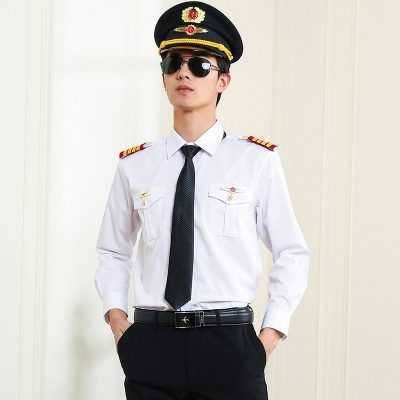
Custom Aviation Uniform Design: Reflecting Your Airline's Identity in 2025
In the competitive landscape of Saudi Arabia's aviation sector, custom uniform design has evolved into a strategic brand differentiator that extends far beyond functional requirements. As the Kingdom's aviation industry expands under Vision 2030, airlines are discovering that thoughtfully designed uniforms serve as powerful ambassadors of their brand identity, cultural values, and service excellence, creating lasting impressions that influence passenger perception and loyalty.
The Strategic Role of Aviation Uniforms in Brand Identity
Aviation uniforms function as mobile brand ambassadors, delivering measurable business impact:
- Brand Recognition Enhancement: Distinctive uniform designs can increase airline brand recall by up to 45% among passengers, creating immediate visual association with service quality and reliability.
- Professional Credibility: Well-designed uniforms enhance perceived competence, with studies showing that passengers rate crew professionalism 35% higher when uniforms reflect strong brand identity.
- Cultural Representation: Thoughtful design integration of Saudi cultural elements demonstrates respect for local heritage while projecting global sophistication.
- Employee Pride & Performance: Crew members wearing distinctive, high-quality uniforms report 28% higher job satisfaction and stronger organizational identification.
- Competitive Differentiation: Unique uniform designs help airlines stand out in crowded airports and create memorable passenger experiences.
Aviation Uniform Impact Study: KSA Airlines (2025)
- Airlines with custom-designed uniforms achieve 22% higher brand recognition scores in passenger surveys.
- Premium uniform designs correlate with 18% increased passenger satisfaction ratings for service quality.
- Culturally-integrated uniform elements improve local market perception by 31% among Saudi passengers.
Design Philosophy for Aviation Excellence
Successful aviation uniform design balances multiple critical elements:
1. Brand DNA Integration
- Color Psychology: Strategic use of airline brand colors to evoke trust, reliability, and sophistication while ensuring visibility and professionalism.
- Logo Placement & Scaling: Optimal positioning of airline insignia for maximum brand exposure without compromising uniform aesthetics.
- Typography Integration: Incorporating airline fonts and design elements into uniform details like name tags, badges, and accessories.
- Brand Storytelling: Using design elements to communicate airline values, heritage, and service philosophy through visual cues.
2. Cultural Sensitivity & Local Adaptation
- Saudi Cultural Elements: Respectful integration of traditional patterns, colors, or motifs that resonate with local heritage.
- Modesty Considerations: Ensuring designs meet cultural expectations for appropriate coverage while maintaining international aviation standards.
- Regional Preferences: Adapting designs to reflect Middle Eastern aesthetic preferences while maintaining global appeal.
- Religious Accommodation: Designing flexible uniform systems that accommodate religious practices and requirements.
3. Functional Excellence
- Climate Adaptability: Designing for Saudi Arabia's diverse climate conditions, from air-conditioned cabins to hot tarmac environments.
- Movement & Comfort: Ensuring uniforms support the physical demands of aviation work while maintaining professional appearance.
- Durability Standards: Selecting materials and construction methods that withstand frequent wear, cleaning, and travel stresses.
- Safety Integration: Incorporating required safety features without compromising aesthetic appeal.
Design Elements That Define Aviation Excellence
Color Strategy & Psychology
Color selection in aviation uniforms carries significant psychological and practical implications:
- Trust & Reliability Colors: Navy blue, deep burgundy, and forest green convey stability and professionalism.
- Energy & Innovation: Strategic accent colors can communicate dynamism and forward-thinking approach.
- Cultural Resonance: Colors that hold positive associations in Saudi culture, such as specific shades of green or gold.
- Practical Considerations: Colors that maintain appearance despite frequent cleaning and potential staining.
Silhouette & Cut Innovation
- Contemporary Tailoring: Modern cuts that flatter diverse body types while maintaining professional standards.
- Layering Systems: Coordinated pieces that work together for different climates and occasions.
- Gender-Specific Design: Tailored approaches that respect cultural norms while ensuring comfort and functionality.
- Rank Differentiation: Subtle design variations that clearly indicate crew hierarchy and responsibilities.
Premium Materials & Fabrication
- Performance Fabrics: Advanced textiles offering moisture management, wrinkle resistance, and durability.
- Sustainable Options: Eco-friendly materials that align with airline sustainability commitments.
- Comfort Technologies: Fabrics with stretch, breathability, and temperature regulation properties.
- Easy Care Properties: Materials that maintain appearance with minimal maintenance requirements.
Customization Levels & Options
Complete Custom Design
Full bespoke uniform programs offering maximum brand differentiation:
- Original Pattern Development: Creating unique silhouettes and cuts specific to the airline.
- Exclusive Fabric Development: Custom weaves, colors, and patterns not available to competitors.
- Signature Details: Unique buttons, trim, and finishing touches that become brand signatures.
- Comprehensive Accessory Design: Coordinated shoes, bags, scarves, and jewelry that complete the look.
Semi-Custom Adaptation
Modifying existing designs to reflect airline identity:
- Color Customization: Adapting proven designs in airline brand colors.
- Logo Integration: Adding airline branding to established uniform styles.
- Detail Modification: Adjusting trim, buttons, and accessories to reflect brand identity.
- Cultural Adaptation: Modifying international designs for local market preferences.
The Design Development Process
Phase 1: Brand Analysis & Concept Development
- Brand Audit: Comprehensive analysis of airline identity, values, and market positioning.
- Competitive Analysis: Studying industry trends and competitor approaches to identify differentiation opportunities.
- Cultural Research: Understanding local preferences and cultural considerations for the Saudi market.
- Concept Creation: Developing initial design concepts that align with brand strategy.
Phase 2: Design Refinement & Prototyping
- Stakeholder Feedback: Incorporating input from airline management, crew representatives, and brand teams.
- Technical Development: Refining designs for manufacturability and functionality.
- Prototype Creation: Developing sample garments for fit, function, and appearance evaluation.
- Testing & Validation: Conducting wear trials with actual crew members in operational environments.
Phase 3: Production & Implementation
- Manufacturing Partner Selection: Choosing suppliers capable of delivering consistent quality at scale.
- Quality Control Systems: Implementing rigorous standards for construction, fit, and appearance.
- Rollout Planning: Coordinating uniform distribution and training for proper wear and care.
- Performance Monitoring: Tracking uniform performance and gathering feedback for future improvements.
Technology Integration in Modern Aviation Uniforms
- Smart Fabrics: Integration of temperature-regulating and moisture-wicking technologies.
- RFID Integration: Embedded chips for inventory management and authentication.
- Antimicrobial Treatments: Advanced finishes that maintain hygiene during long flights.
- Wrinkle-Free Technologies: Fabrics that maintain crisp appearance throughout duty periods.
- UV Protection: Built-in sun protection for crew working in high-altitude environments.
Sustainability in Aviation Uniform Design
Environmental consciousness is increasingly important in aviation uniform programs:
- Recycled Materials: Using fabrics made from recycled plastic bottles or other sustainable sources.
- Circular Design: Creating uniforms designed for recycling at end of life.
- Local Sourcing: Reducing transportation impact through regional manufacturing partnerships.
- Durability Focus: Designing for longevity to reduce replacement frequency.
- Eco-Friendly Processes: Using sustainable dyeing and finishing methods.
Cost Considerations & ROI
- Initial Investment: Custom design development costs typically range from $50,000-$200,000 depending on complexity.
- Per-Unit Costs: Custom uniforms may cost 20-40% more than standard options but deliver superior brand value.
- Lifecycle Value: Higher quality custom uniforms often last 30-50% longer than standard alternatives.
- Brand ROI: Enhanced brand recognition and passenger satisfaction can justify premium investment.
- Employee Satisfaction: Improved crew morale and retention provide additional value beyond direct costs.
Implementation Best Practices
- Stakeholder Engagement: Involving crew members, management, and brand teams in the design process.
- Phased Rollout: Implementing new uniforms gradually to manage logistics and gather feedback.
- Training Programs: Educating crew on proper uniform wear, care, and brand representation.
- Feedback Systems: Establishing channels for ongoing input and continuous improvement.
- Performance Metrics: Tracking uniform performance, crew satisfaction, and brand impact.
Conclusion: Uniforms as Strategic Brand Assets
In Saudi Arabia's dynamic aviation market, custom uniform design represents a powerful opportunity to differentiate airline brands, enhance passenger perception, and strengthen organizational culture. By thoughtfully integrating brand identity, cultural sensitivity, and functional excellence, airlines can create uniform programs that serve as strategic assets rather than mere operational necessities.
As the Kingdom's aviation sector continues to expand and evolve, airlines that invest in distinctive, well-designed uniform programs will find themselves better positioned to attract passengers, retain talent, and build lasting brand recognition in an increasingly competitive marketplace.
About the Author

Yasmin Al-Zahrani
Yasmin Al-Zahrani is a leading Aviation Uniform Design Specialist with over 12 years of experience working with airlines across the Middle East. She has designed custom uniform programs for major carriers, specializing in creating designs that balance international aviation standards with regional cultural preferences and brand identity requirements.
Create Your Airline's Signature Uniform Design
Transform your airline's brand identity with custom uniform design that reflects your values, culture, and commitment to excellence. UniformSA offers comprehensive aviation uniform design services tailored to the Saudi market.
Request Custom Design Consultation